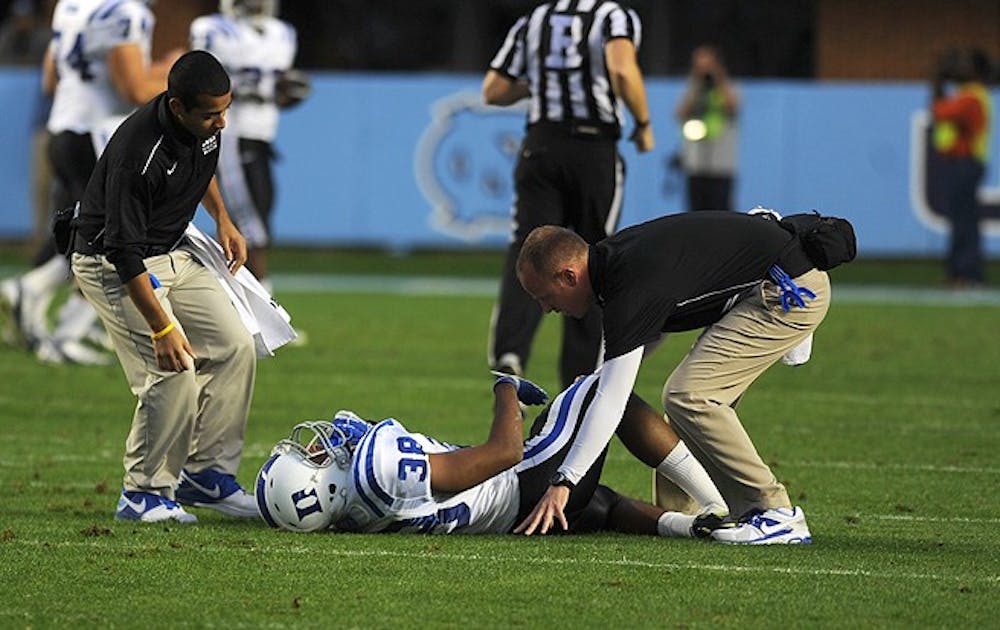Both on and off the field, Duke’s sports medicine department keeps a watchful eye on Blue Devil athletes.
All team sports at Duke have equal access to medical treatment, but Dr. Claude Moorman III, director of the Duke Sports Medicine Center and head team physician, said the medical presence at each event varies based on the typical injuries that athletes in each sport sustain. Because some teams—including football, lacrosse, soccer and field hockey—are at higher risk than others for injury, a physician is always at those games alongside the athletic trainers. For sports with less likelihood of traumatic injuries, physicians are not necessarily on site but are available when needed.
Since many of the football players remain at Duke during the summer for training or classes, football has become a nearly year-round sport, he said. Most injuries, however, occur during scrimmages and games rather than at practices.
“We see some [injuries in practice], but not ordinarily,” said Moorman, who is also vice chair of orthopedic surgery. “Coach Cutcliffe does a great job of finding that balance between giving them just enough contact so they get exposure and are ready to play but not getting too much that we get a lot of injuries.”
While Moorman could not comment on specific cases, he noted that most of the injuries on the football field are muscle strains, which are nagging but will not necessarily keep a player out of the game.
When on the road, the football team travels with one orthopedist and one primary care sports medicine attending—usually Moorman and team physician Dr. Jeffrey Bytomski.
If an athlete sustains an injury that prevents them from traveling safely—such as a fracture in the femur or humerus—Moorman said that to prevent complications the team physicians work in conjunction with the opposing school’s sports medicine departments.
“There’s a really a wonderful sense of camaraderie among institutions as it relates to care of the athletes, so generally we know the people well throughout the ACC,” Moorman said.
Almost every stadium in the ACC has X-ray facilities on site in case of suspected fractures, he said. At Duke, there is a full clinic at the stadium, equipped with a minor procedure room, casting facilities and an X-ray machine. For serious injuries that require more involved treatment, athletes go to Duke Hospital.
Moorman played football at Duke form 1979 to 1983. During his sophomore year, he experienced a knee injury, and with the encouragement of the late Dr. Frank Bassett, Duke’s team physician from 1966 to 1993 and a member of the Duke Sports Hall of Fame, he decided to go into medicine.
“The opportunity to take care of the team that you played on while you were here is really exciting for me and that’s a dream come true,” Moorman said. “That’s why I’ve continued to take care of football—I just love the sport, love the people.”
For Duke athletes like Moorman who want to get involved with sports medicine, the Bassett Society, a group of more than 300 former Duke athletes who attended medical or dental school, awards two scholarships yearly. Students also have the opportunity to work in the K-Lab—a center dedicated to the understanding and prevention of athletic injury—or on independent projects.
“There are a lot of opportunities, and we’re always excited to get to know the students who might have an interest in medicine,” he said.
The strength of Duke’s sports medicine, Moorman noted, helps with recruiting as well. Duke’s primary care and orthopedic sports medicine fellowships—specialty training after a physician completes his or her residency—are ranked in the top five in the nation. At least one of these fellows accompanies Moorman and Botomski to each game. Orthopedic residents also travel with the team.
“We have a great group of professionals that come together—our athletic trainers, physical therapists, primary care sports doctors and orthopedists—and all really work as a team with the only real goal of trying to do the best we can for any of our student athletes who are injured,” he said.
Get The Chronicle straight to your inbox
Signup for our weekly newsletter. Cancel at any time.

